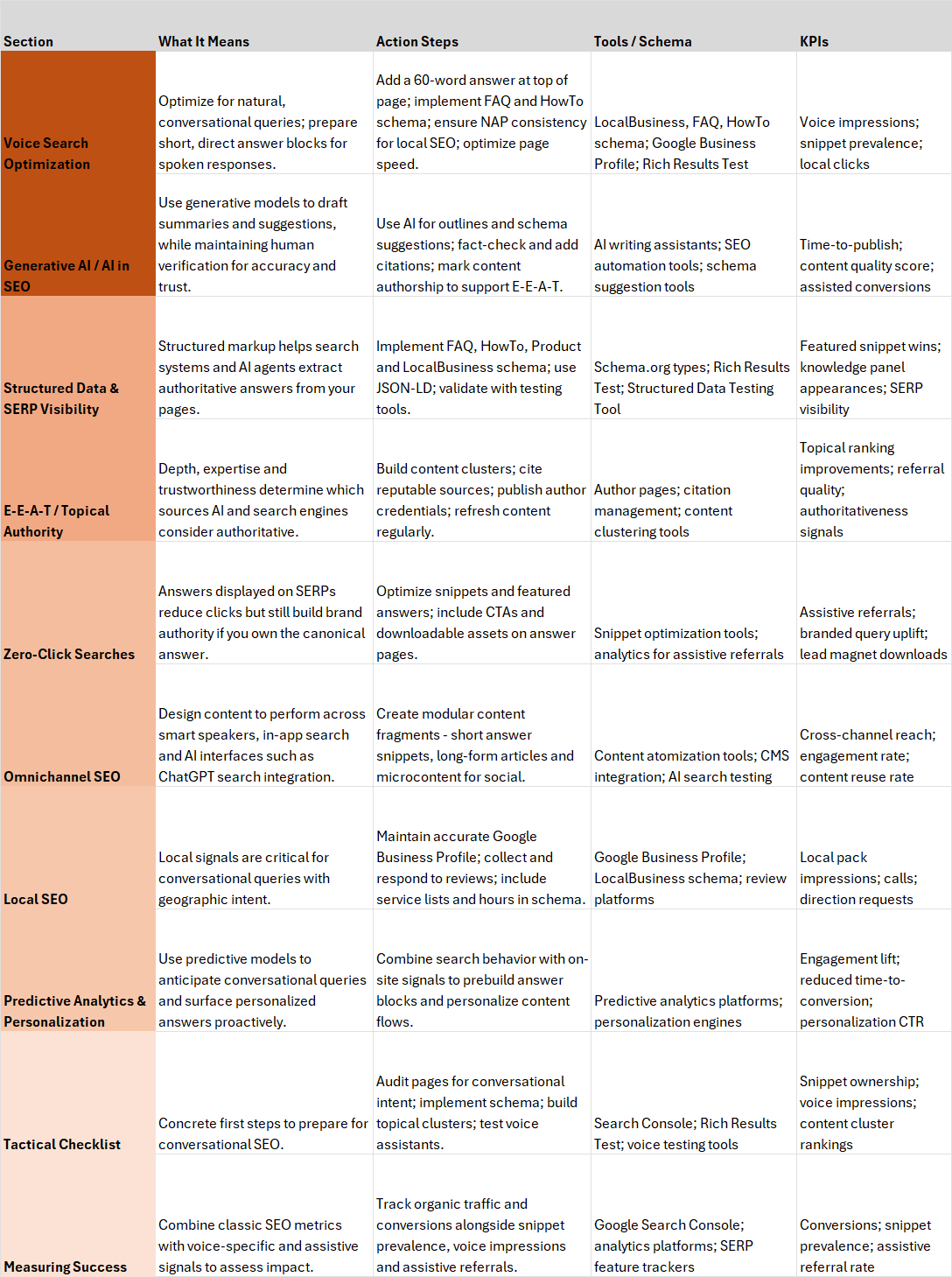The future of SEO is being shaped by two related trends: voice interfaces and generative AI. Voice search optimization focuses on how users ask questions and how devices return spoken answers. Generative AI changes how answers are produced and summarized. Together they influence SEO evolution, but each requires a different set of priorities and technical work.
Exploring trends in the future of SEO
If you conflate voice with AI, your strategy becomes unfocused. The future of SEO means optimizing both the delivery channel and the answer-generation layer. Voice search optimization demands crisp, local-ready responses and structured data. AI in SEO requires topical depth, citations and E-E-A-T / Topical Authority. Knowing which levers to pull for each use case is the practical difference between being surfaced by a smart speaker and being cited by an AI search engine.
Voice search optimization and conversational queries
Voice search optimization is about conversational queries and immediacy.
- Write concise, direct answers at the top of the page: 30-60 words work best for spoken readouts.
- Use Local Business schema and keep NAP consistent for local SEO intent.
- Optimize page speed and mobile-first design to ensure fast responses.
- Add FAQ and How To schema so assistants can extract usable snippets.
These measures increase your chances of being the spoken result and improve overall SERP visibility.
Generative AI in SEO
Generative AI changes who crafts the answer and how complex summaries are created. For AI in SEO, priorities shift toward trust and depth:
- Build topical clusters that demonstrate expertise and support conversational snippets.
- Publish author credentials and cite reputable sources to satisfy E-E-A-T / Topical Authority signals.
- Use structured data to improve the quality of content that models can reference.
- Treat AI-generated drafts as starting points – always verify facts and add provenance.
Generative models may generate fluent responses, but in the future, search engines will reward sites that models can trust and reliably cite.
Zero-click searches
Zero-click searches will increase as both voice and AI deliver answers directly on the SERP or through assistants. In the future, SEO goal would be less about forcing clicks and more about owning the canonical answer:
- Optimize for featured snippets and knowledge panels.
- Include CTAs, downloadable assets and micro-conversion paths on pages that earn snippets.
- Track assistive referrals to measure value delivered even when clicks decline.
Own the answer and you still own authority – that’s the practical shift for spoken search.
Recommended for reading: Top Benefits of Partnering with a Digital Marketing Agency
Gearing up for the future of SEO
- Structured data and SERP visibility
Structured data remains a foundation for conversational SEO and AI extraction.
- Implement FAQ, How To, Product and Local Business schema across relevant pages.
- Use JSON-LD and validate with testing tools to ensure clean markup.
- Structured data improves both voice agent extraction and AI search engines’ ability to cite your content.
This technical hygiene directly improves SERP visibility and the likelihood of being chosen by assistants and models.
E-E-A-T, topical authority and long-form support
Short answer snippets matter, but they must sit on a bedrock of in-depth content.
- Create clusters of long-form content that link to your short answer pages.
- Use expert contributors and transparent sourcing.
- Refresh content regularly to keep topical authority current.
Topical authority is what makes AI search engines prefer your site as a source – a critical axis in the world of AI-driven search.
Omnichannel SEO and ChatGPT search integration
Search now happens across devices and interfaces. Omnichannel SEO anticipates that fragmentation and prepares content accordingly:
- Produce modular content: short answer snippets for voice, long articles for on-page depth and microcontent for social.
- Test performance in ChatGPT search integration and other AI search interfaces to understand how your content appears in different formats.
- Use SEO automation to distribute and tag content for each channel efficiently.
An omnichannel approach ensures consistent presence as the future of SEO expands beyond traditional web search.
Predictive analytics, personalization and local signals
Predictive analytics can prebuild the answers users will likely ask next. In the future:
- Use behavior data to anticipate conversational queries and prepopulate answer blocks.
- Combine personalization with local SEO tactics – many voice queries are location specific.
- Keep Google Business Profile details accurate and encourage reviews to improve local SERP visibility.
Predictive work improves relevance – a direct win for voice and AI scenarios.
Recommended for reading: Top 10 Content Marketing Trends to Watch in 2025
Health and hygiene
To future-proof your conversational SEO strategy, don’t ignore performance and experience metrics – monitor Core Web Vitals, mobile-first SEO, and UX signals closely.
These technical and behavioral indicators influence how search engines and AI agents evaluate page quality, so improving load times, mobile usability and interaction metrics will boost both SERP visibility and user satisfaction.
Tactical checklist: Quick wins for this quarter
- Audit high-traffic pages and add concise answer blocks for voice agents.
- Implement and validate structured data across priority pages.
- Build topical clusters to support short answers and strengthen E-E-A-T.
- Use AI tools for outlines and schema suggestions (always verify for accuracy).
- Test responses on Google Assistant, Alexa and ChatGPT-style search; track snippet ownership.
These steps produce measurable gains and move you toward being present across modern search surfaces

Recommended for reading: How Data-Driven SEO Strategies Can Boost Your Online Presence
Measuring success in a voice-first world
Combine classic KPIs with voice-specific signals: organic traffic, conversions, snippet prevalence, voice impressions and assistive referrals. Monitor SERP visibility for featured snippets and knowledge panels and tie those signals to engagement metrics. That composite view shows whether your work is winning visibility.
Conclusion
Voice Search Optimization and generative AI are distinct but complementary forces shaping the future of SEO. Optimize for both – short, machine-friendly answers for voice, and deep, trustworthy content for AI models. Start with technical hygiene – structured data and site speed – then layer on topical authority and validated AI workflows. Small pilots, focused on measurable KPIs, will compound into clear advantage as search becomes more conversational and more automated.
Want help separating channel strategy from AI strategy and building a practical roadmap for the future of SEO? We combine technical SEO, content strategy and pragmatic AI workflows to help you win across voice and generative-AI surfaces.
.svg)





